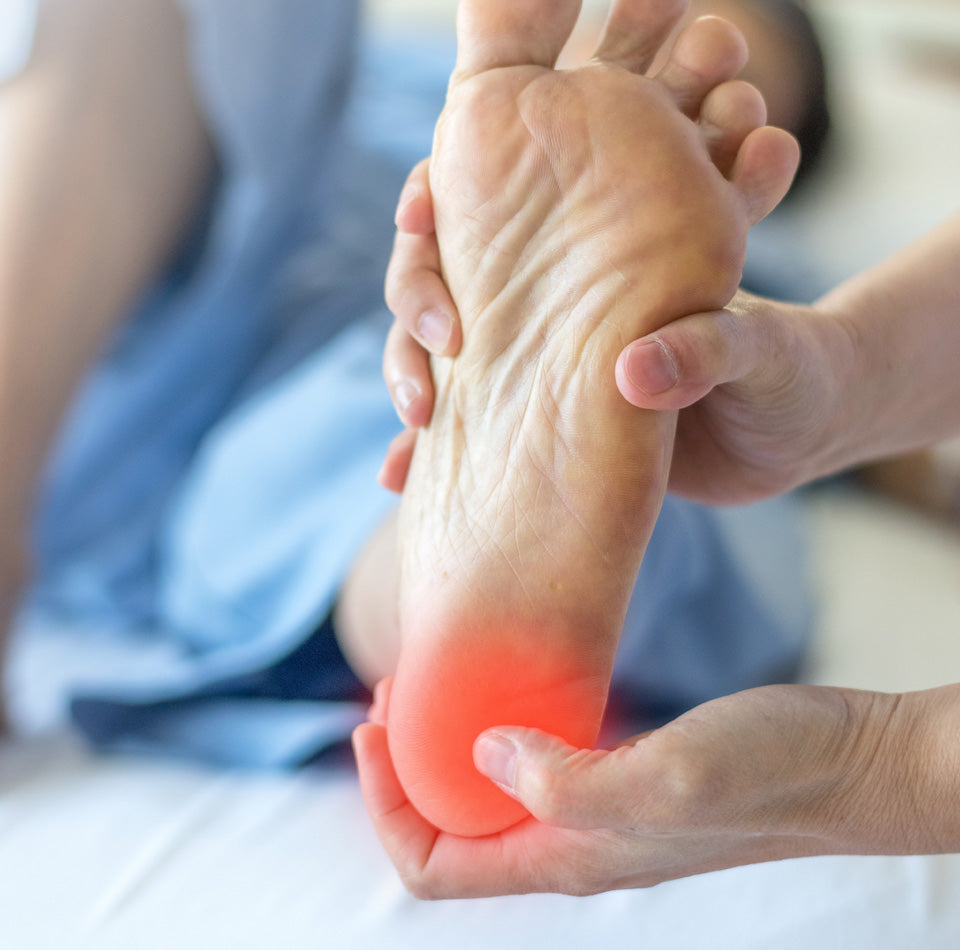If you want to avoid plantar fasciitis this Easter, try these 10 simple tips. Prioritising foot health ensures that you can fully participate in holiday activities without discomfort. Take care of your feet, and they will take care of you!
How to avoid plantar fasciitis this Easter: top tips for happy, pain-free feet
Easter is a time for celebration, family gatherings, and outdoor activities. However, if you’re not careful, all the walking, standing, and running around can lead to foot pain, specifically plantar fasciitis.
What is plantar fasciitis?
Plantar fasciitis is an over-use injury which results in inflammation of the plantar fascia, the thick band of tissue that supports the arch of your foot. Pain typically presents underneath the heel, where the plantar fascia attaches to the heel bone (known as the calcaneous). However, sometimes plantar fasciitis pain can present underneath the arch of the foot instead. Plantar fasciitis tends to be most painful when you take those first few steps in the morning or after a long period of rest – such as getting out of bed, or going to the toilet during the night.
Podiatrist tips to avoid plantar fasciitis
To ensure your Easter festivities remain enjoyable and pain-free, follow these expert tips on how to avoid plantar fasciitis.
- Wear supportive footwear
Whether you’re participating in an Easter egg hunt, attending church services, or spending time at a family gathering, your choice of footwear is crucial. Avoid unsupportive shoes like flip-flops, ballet flats, or worn-out trainers. Instead, opt for:
- Trainers with a thick, supportive and well-structured sole (e.g. athletic/running style trainers)
- Soles with plenty of cushioning and shock absorption – replace your trainers every 300-500 miles (or every 6-12 months)
- Footwear with adjustable fastenings, such as laces or Velcro straps
- Consider wearing insoles/orthotics with cushioning and/or arch support to improve the positioning of your feet and reduce over-pronation
- Stretch your feet and calf muscles regularly
Stretching your feet and calf muscles can help prevent (and treat) plantar fasciitis by keeping your plantar fascia flexible and reducing tension. Try these simple stretches:
- Toe stretches: Pull your toes back gently to stretch the arch. If you are already suffering with plantar fasciitis, try massaging the tender spot whilst holding this stretch – this will further reduce tension in the fascia.
- Calf stretches: Performing a simple lunge stretch against the wall is an effective way to stretch the calf muscles – make sure your heels are firmly on the ground and lean forward until you feel a gentle stretch in your calf muscle, and hold for at least 30 seconds.
- Rolling stretches: Roll a tennis ball or chilled water bottle under your foot.
- Avoid walking barefoot
Walking barefoot, especially on hard surfaces, can strain the plantar fascia. Whether you’re at home or outdoors, wear supportive slippers or shoes to keep your feet protected and cushioned.
- Maintain a healthy weight
Extra body weight puts additional pressure on your feet, increasing the risk of plantar fasciitis. This Easter, enjoy your favourite treats in moderation and engage in low-impact activities like swimming or cycling to keep your weight in check.
- Take breaks and elevate your feet
If you’re on your feet all day preparing Easter meals or chasing after kids, be sure to take breaks. Sit down, elevate your feet, and give them a chance to rest.
- Ice your feet if needed
If you start feeling any discomfort, ice your heels for 15-20 minutes to reduce inflammation. This simple remedy can prevent minor aches from turning into a more severe case of plantar fasciitis.
- Strengthen your foot muscles
Incorporate strengthening exercises like toe curls, towel scrunches, and resistance band exercises to improve foot stability and prevent strain on the plantar fascia.
- Be mindful of your activities
Easter weekend may involve a lot of walking, running, or jumping. Avoid overexertion, especially if you’re not used to prolonged activity. If you’re planning a hike or a long walk, prepare ahead with proper footwear and stretching.
- Try orthotic insoles
Custom orthotics or over-the-counter insoles can make a huge difference in preventing foot pain. They provide the additional arch support and cushioning, reducing stress on your plantar fascia.
- Stay hydrated and maintain good nutrition
Inflammation can worsen plantar fasciitis pain. A balanced diet rich in anti-inflammatory foods such as leafy greens, nuts, and omega-3 fatty acids can help keep inflammation at bay.
Conclusion
By following these preventive measures, you can enjoy a pain-free Easter and keep plantar fasciitis at bay. Prioritising foot health ensures that you can fully participate in holiday activities without discomfort. Take care of your feet, and they will take care of you!

